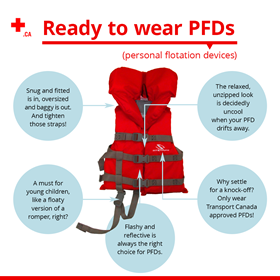
Victoria Day long weekend is a first chance for many folks to get their docks set up, prep boats for the season, and head out on the open water. But cold water is an important factor to consider, well into the summer season. The Canadian Red Cross has some water safety tips to help you enjoy the water – safely.
“The most important thing is to be prepared,” said Lesley-Anne Morley, Canadian Red Cross injury prevention manager in Saskatchewan. “The number one way to prepare is to wear a Canadian-approved Personal Flotation Device (PFD). Every year, avoidable boating-related fatalities occur across the country. The proper use of PFDs would greatly reduce this number. Personal Flotation Devices are specially designed for a variety of activities so choose a PFD that can provide insulation against cold water.”
When choosing a Personal Flotation device, use this
checklist:
- Is it Canadian-approved?
- Will it support the person it was made for?
- Are all the snaps, belts, ties, tapes and/or zippers in good condition?
- Is it easy to put on and take off?
- Can you move your arms freely when wearing it?
- Does it let you bend at the waist?
- Can you see the ground at your feet and walk over obstacles easily?
- Does it keep your head above water?
- Can you swim and manoeuvre easily in the water?
- Have you attached a whistle to your flotation device?
In case someone does get submerged, watch for signs of hypothermia ranging from mild to severe.
- Mild hypothermia involves vigorous shivering, complaining of the cold, decreased physical function and difficulty taking care of self.
- Moderate hypothermia involves weak and intermittent shivering or shivering that later stops, sometimes complaining of the cold, lack of coordination or speech, confused or unusual behaviour, impaired judgment, and possible unresponsiveness.
- Severe hypothermia involves shivering that has stopped, unresponsiveness, breathing that has slowed down or stopped, the body feels stiff, and no pulse.“When treating hypothermia, if there are other people around, get into a HUDDLE”, advises Morley. “HUDDLE with everyone’s chests and sides close together. Intertwine legs and extend your arms around the people next to you. You can increase your survival time by 50% using this method.”
Ensuring that everyone is wearing a Personal Floatation Device, keeping an eye out for changing weather conditions, and knowing the signs and treatments for hypothermia, will help you safely navigate the wonderful long weekends of a Canadian summer.